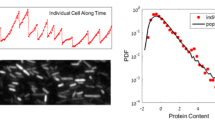Abstract
We study the evolution of simple cells equipped with a genome, a rudimentary gene regulation network at transcription level and two classes of functional genes: motion effectors which allow the cell to move in response to nutrient gradients and nutrient importers required to actually feed from the environment. The model is inspired by the protist Naegleria gruberi which can switch between a feeding and dividing amoeboid state and a mobile flagellate state depending on environmental conditions. Simulation results demonstrate how selection in a variable environment affects the gene number and efficiency making the cells to rapidly switch from one expression regime to the other depending on the external conditions.
Access this chapter
Tax calculation will be finalised at checkout
Purchases are for personal use only
Preview
Unable to display preview. Download preview PDF.
Similar content being viewed by others
References
Banzhaf, W.: On the dynamics of an artificial regulatory network. In: Banzhaf, W., Ziegler, J., Christaller, T., Dittrich, P., Kim, J.T. (eds.) ECAL 2003. LNCS (LNAI), vol. 2801, pp. 217–227. Springer, Heidelberg (2003)
Benkö, G., Flamm, C., Stadler, P.F.: A graph-based toy model of chemistry. J. Chem. Inf. Comput. Sci. 43, 1085–1093 (2003)
Deckard, A., Sauro, H.M.: Preliminary studies on the in silico evolution of biochemical networks. ChemBioChem. 5, 1423–1431 (2004)
Ebner, M., Shackleton, M., Shipman, R.: How neutral networks influence evolvability. Complex 7(2), 19–33 (2001)
Eggenberg, P.: Evolving morphologies of simulated 3D organisms based on differential gene expression. In: Proc. ECAL 1997, pp. 205–213. The MIT Press/Bradford Books (1997)
Fontana, W.: Modelling ’evo-devo’with RNA. BioEssays 24, 1164–1177 (2002)
Fontana, W., Schuster, P.: Shaping space: The possible and the attainable in RNA genotype-phenotype mapping. J. Theor. Biol. 194, 491–515 (1998)
Forst, C.V., Reidys, C.M., Weber, J.: Evolutionary dynamics and optimization: Neutral Networks as model-landscape for RNA secondary-structure folding-landscapes. In: Morán, F., Merelo, J.J., Moreno, A., Chacon, P. (eds.) ECAL 1995. LNCS (LNAI), vol. 929, pp. 128–147. Springer, Heidelberg (1995)
François, P., Hakim, V.: Design of genetic networks with specified functions by evolution in silico. Proc. Natl. Acad. Sci. USA 101(2), 580–585 (2004)
Fulton, C., Walsh, C.: Cell differentiation and flagellar elongation in Naegleria gruberi. J. Cell Biol. 85, 346–360 (1980)
Geard, N., Wiles, J.: Structure and dynamics of a gene network model. In: Proc. CEC 2003, pp. 199–206. IEEE Press, Los Alamitos (2003)
Hofacker, I.L.: Vienna RNA secondary structure server. Nucl. Acids Res. 31, 3429–3431 (2003)
Huynen, M.A., Stadler, P.F., Fontana, W.: Smoothness within ruggedness: the role of neutrality in adaptation. Proc. Natl. Acad. Sci. (USA) 93, 397–401 (1996)
Jacob, F., Monod, J.: On the regulation of gene activity. In: Cold Spring Harbor Symp. Quant. Biol., vol. 26, pp. 193–211 (1961)
Kenneth, S.O., Risto, M.: Efficient Reinforcement Learning through Evolving Neural Network Topologies. In: Proc. GECCO-2002, pp. 569–577. Morgen Kaufman, San Francisco (2002)
Klug, S., Famulok, M.: All you wanted to know about SELEX. Mol. Biol. Reports 20, 97–107 (1994)
Athanasius, F.M., Marée, M., Hogeweg, P.: Modelling Dictyostelium discoideum Morphogenesis: the Culmination. Modelling Dictyostelium discoideum Morphogenesis: the Culmination. Bull. Math. Biol. 64, 327–353 (2002)
Merks, R.M.H., Glazier, J.A.: A cell-centered approach to developmental biology. Physica A (2005) (in press)
Reil, T.: Dynamics of gene expression in an artificial genome – inplications for biological and artificial ontogeny. In: Floreano, D., Mondada, F. (eds.) ECAL 1999. LNCS, vol. 1674, pp. 457–466. Springer, Heidelberg (1999)
Schuster, P., Fontana, W., Stadler, P.F., Hofacker, I.L.: From sequences to shapes and back: A case study in RNA secondary structures. Proc. Roy. Soc. Lond. B225, 279–284 (1994)
Stadler, P.F.: Fitness landscapes arising from the sequence-structure maps of biopolymers. J. Mol. Struct. (THEOCHEM) 463, 7–19 (1999); Santa Fe Institute Preprint 97-11-082
van Nimwegen, E., Crutchfield, J.P., Huynen, M.A.: Neutral evolution of mutational robustness. Proc. Natl. Acad. Sci. USA 96, 9716–9720 (1999)
Author information
Authors and Affiliations
Editor information
Editors and Affiliations
Rights and permissions
Copyright information
© 2005 Springer-Verlag Berlin Heidelberg
About this paper
Cite this paper
Attolini, C.SO., Stadler, P.F., Flamm, C. (2005). CelloS: A Multi-level Approach to Evolutionary Dynamics. In: Capcarrère, M.S., Freitas, A.A., Bentley, P.J., Johnson, C.G., Timmis, J. (eds) Advances in Artificial Life. ECAL 2005. Lecture Notes in Computer Science(), vol 3630. Springer, Berlin, Heidelberg. https://doi.org/10.1007/11553090_51
Download citation
DOI: https://doi.org/10.1007/11553090_51
Publisher Name: Springer, Berlin, Heidelberg
Print ISBN: 978-3-540-28848-0
Online ISBN: 978-3-540-31816-3
eBook Packages: Computer ScienceComputer Science (R0)




